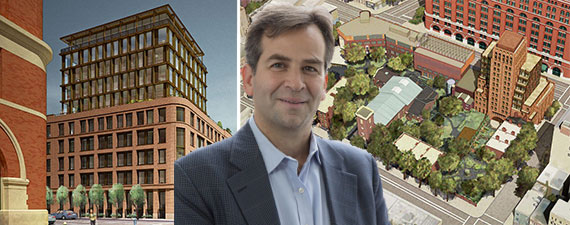Trending
The church thinks in centuries, but real estate brokers deal in 99 years
Ground-lease deal between St. Luke’s and Toll Brothers in Village up for REBNY "Ingenious" award

It may sound like the plot of Dan Brown’s next novel, but this story involving religious organizations, ritual meetings and ancient crypts is actually a tale of a real estate deal.
Working on behalf of the Church of St. Luke in the Fields, broker Paul Wolf negotiated a 99-year ground lease on the church’s West Village campus with Toll Brothers City Living. The deal will see the church reap around $800 million over the lease term.
Wolf’s recounting of the deal, titled “The Church of Saint Luke in the Fields: Designing a Road Map for the Next 100 Years,” is one of nine lease transactions up for the Real Estate Board of New York’s “Most Ingenious Deal of the Year Award.”
REBNY will announce the winners April 12, and in the run-up to the event The Real Deal is reviewing a number of the submissions to give readers an inside look at how some of the city’s trickiest deals are done. (They include David Ash’s retail condo for Zara, Arthur Mirante’s NBPA office lease and Rob Martin’s space swap for Assured Guaranty.)
Wolf, a principal at Denham Wolf, a brokerage that specializes in working with nonprofits, started working on the deal back in 2007, when the church brought him on to help the institution secure its financial footing by leveraging its real estate holdings.
Founded in 1820, the church owns a full city block between Hudson, Barrow, Christopher and Greenwich streets.
On top of the global recession that delayed any deal, there were a number of challenges to overcome, one being the Episcopal church’s organizational structure. In the church, the parish’s policy and financial matters are handled by a group of elected lay people known as the vestry, who serve limited terms.
That means that the leadership was turning over amid the negotiations.
“This arrangement has the benefit of facilitating fresh ideas, but it can also hinder successful decision-making for projects with durations that exceed leaders’ terms,” Wolf wrote in his submission.
To overcome this hurdle, Wolf worked with the institution’s leaders to set up an ad-hoc planning committee that would provide continuity over the course of negotations.
Another challenge was to find what Wolf described as an “optimal” solution rather than a “maximal” one: a deal that would provide the church with solid cash flow but also accommodate its closely affiliated school.
The Saint Luke’s School had long been a program operated by the church, but when it became an independent institution in 2012, the church leadership thought about bringing a rent-paying tenant into the educational space.
The team realized the school could afford to pay rent, but that would require an expansion.
“There was no obvious way to fund an expansion without the church and school agreeing to a long-term lease for the school,” Wolf wrote.
The solution: Working with his colleague Stephen Powers, Wolf negotiated a below-market, 49-year ground lease between the school and the church, a deal that helped the school raise $20 million to invest in a 20,000-square-foot expansion.
The lease included community space for the church’s programs and conflict-resolution components requiring church and school leaders to meet regularly, which they elected to do weekly over coffee.
The next step was to find a developer. In 2013 Wolf engaged the architecture firm Beyer Blinder Belle to assess the site’s zoning, infrastructure and landmark issues. It was essential to find a developer who would take an “archeologically sensitive approach” to the campus, Wolf said, particularly when it came to the church’s crypts.
Wolf then issued a request for proposals and selected Toll Brothers. The developer agreed to accommodate the church by covering soft costs until the lease was signed, and assented to rent escalations and multiple resets that Wolf said mitigated nearly all of the church’s financial risk in the deal.
Toll is developing a 75,000-square-foot residential building at site, known as 100 Barrow Street.
“In many ways, Toll Brothers acquired significant risk by participating in this project,” Wolf wrote. “In exchange, they have the opportunity to build new residences in an incredibly desirable neighborhood, which rarely sees the opportunity for new construction.”




